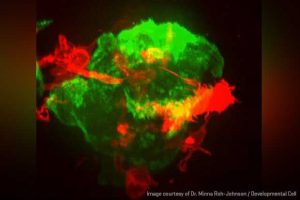How macrophages promote melanoma metastasis
Researchers have visualized macrophages transferring cytoplasm to melanoma tumor cells, contact which in turn alters tumor cell migration and stimulates cancer metastasis.
The study, which cites our MC-38 adenocarcinoma cell line, was recently published in the journal Developmental Cell.
Macrophages: good or bad guys?

Human melanoma cells (green) transplanted into zebrafish are surrounded by and interact with the fish immune cells called macrophages (red). Image courtesy of Minna Roh-Johnson / Developmental Cell.
Macrophages are white blood cells that digest pathogens and cellular debris. Found in every type of tissue, macrophages are part of the innate immune system, which is activated quickly after an antigen appears within the body.
Though they typically function as our body’s initial defense mechanism, macrophages also have been shown to play a negative role in cancer. For example, research has demonstrated that in many types of human tumors, an increased number of macrophages is correlated with a higher probability of metastasis and worse patient outcomes.
The new study, led by researchers from the Fred Hutchinson Cancer Research Center, provides new insight into how macrophages are playing a role in the spread of cancer.
Making the transfer
Working with in vitro, zebrafish and mouse models, researchers witnessed macrophages physically contacting and sharing cytoplasm contents with melanoma cells. The cell-to-cell contact could last for up to nine hours. After the contact, the tumor cells’ migration behavior changed dramatically; instead of random meandering, the cells became directionally persistent, moving steadily in one direction.
The researchers conducted a variety of experiments to make these observations. Because zebrafish are see-through, fluorescent-dye labeling of individual cells enabled the researchers to follow individual tumor cells throughout the entire process. In addition, to show that the macrophages and melanoma cells were sharing cytoplasm, they engineered each cell type to produce a new gene. The tumor cells produced a red fluorescent protein that turned green only in the presence of a specific trigger gene from the macrophages.
With these experiments and others, the researchers revealed for the first time an immune cell contacting and sharing its contents with a tumor cell.
Identifying the key factors
It is not clear what is being transferred from the macrophages to the melanoma cells. Macrophages themselves are good at migrating within the body and likely contain a variety of motility-promoting factors. Up next, the researchers hope to pinpoint what these factors are and how they promote metastasis. They will also look to confirm whether the same activity occurs in humans, as well as with other types of cancers.
Once the transfer contents are identified, the information could be used to develop markers for tumors likely to metastasize, or even therapies to stop the spread of cancer. For more information, and to view videos of the cells in action, check out a news story from the Fred Hutchinson Cancer Research Center.
Do you work in this area of research? Our catalog offers a variety of unique lab-made reagents for studying cancer, metastasis and innate immunity, including:
- MC-38 Cell Lines from National Cancer Institute/NIH
- Melanoma Cell Lines from University of Minnesota, Twin Cities
- MDSC/Macrophage Transfection Kit from University of Miami
- Cancer Angiogenesis and Nanomedicine Services from Tel Aviv University


